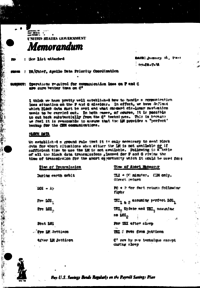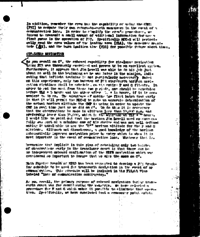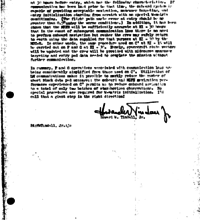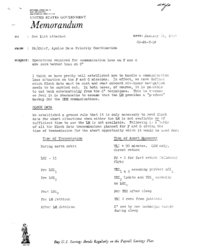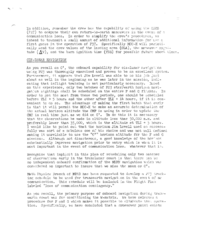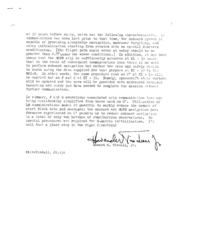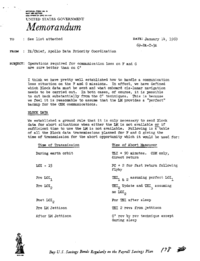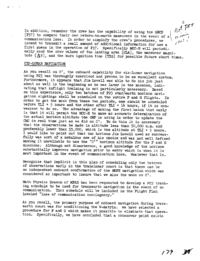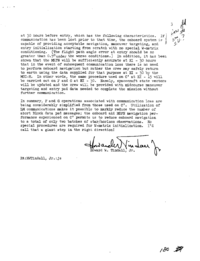See list attachedJanuary 14, 196969-PA-T-3APA/Chief, Apollo Data Priority CoordinationOperations required for communication loss on F and G are sure better than on C’
I think we have pretty well established how to handle a communication loss situation on the F and G missions. In effect, we have defined which Block data must be sent and what onboard cis-lunar navigation needs to be carried out. In both cases, of course, it is possible to cut back substantially from the C' techniques. This is because we feel it is reasonable to assume that the LM provides a “perfect” backup for the CSM communications.
BLOCK DATA
We established a ground rule that it is only necessary to send Block data for abort situations when either the LM is not available or if sufficient time to use the LM is not available. Following is a table of all the Block data transmissions planned for F and G giving the time of transmission for the abort opportunity which it would be used for:
Time of Transmission Time of Abort Maneuver
During earth orbit TLI + 90 minutes. CSM only, direct return
LOI – 15 PC + 2 for fast return following flyby
Pre LOI₁ TEI₁ & ₂ assuming perfect LOI₁
Pre LOI₂ TEI₂ Update and TEI₃ assuming no LOI₂
Post LOI₂ For TEI after sleep
Pre LM Jettison TEI 2 revs from jettison
After LM Jettison C' rev by rev technique except during sleep
In addition, remember the crew has the capability of using the GNCS (P37) to compute their own return-to-earth maneuvers in the event of a communication loss. In order to simplify the crew's procedures, we intend to transmit a small amount of additional information for use a first guess in the operation of P37. Specifically MCC-H will periodi- cally send the crew values of the landing area (CLA), the maneuver magni- tude (ΔV), and the burn ignition time (TIG) for possible future abort times.
CIS-LUNAR NAVIGATION
As you recall on C', the onboard capability for cis-lunar navigation using P23 was thoroughly exercised and proven to be an excellent system. Furthermore, it appears that Jim Lovell was able to do his job just about as well in the beginning as he was later in the mission, indi- cating that inflight training is not particularly necessary. Based on this experience, only two batches of P23 star/earth horizon navi- gation sightings shall be scheduled on the entire F and G flights. In order to get the most from these two periods, one should be scheduled before TLI + 5 hours and the other after TLI + 14 hours, if it is con- venient to do so . The advantage of making the first batch that early is that it will permit the MCC-H to make an accurate determination of the actual horizon altitude the CMP is using in order to update the CMC in real time just as we did on C'. To do this it is necessary that the observations be made in altitude less than 50,000 n.m. and preferably lower than 35,000, which is the altitude at TLI + 5 hours. I would like to point out that the horizon Jim Lovell used so success- fully was sort of a nebulous one of his choice and was not well defined making it unreliable to use the “C'” horizon altitude for the F and G missions. Although not disasterous, a good knowledge of the horizon substantially improves navigation prior to entry which is when it is most important in the event of communication loss. Whatever that is.
Recognize that implicit in this plan of scheduling only two batches of observations early in the translunar coast is that there can be no independent onboard confirmation of the MSFN navigation which was considered so important to insure that we miss the moon on C'.
Math Physics Branch of MPAD has been requested to develop a P23 track- ing schedule to be used for transearth navigation in the event of no communication. This schedule will be included in the Flight Plan labeled “loss of communication contingency.”
As you recall, the primary purpose of onboard navigation during trans- earth coast was for conditioning the W-matrix. We have selected a procedure for F and G which makes it possible to eliminate that opera- tion. Specifically, we have concluded that a crossover point exists at 30 hours before entry, which has the following characteristics. If communication has been lost prior to that time, the onboard system is capable of providing acceptable navigation, maneuver targeting, and entry initialization starting from scratch with no special W-matrix conditioning. (The flight path angle error at entry should be no greater than 0.5° under the worse conditions.) In addition, it has been shown that the MSFN will be sufficiently accurate at EI – 30 hours that in the event of subsequent communication loss there is no need to perform onboard navigation but rather the crew may safely return to earth using the data supplied for that purpose at EI – 30 by the MCC-H. In other words, the same procedure used on C' at EI – 15 will be carried out on F and G at EI – 30. Namely, spacecraft state vectors will be updated and the crew will be provided with midcourse maneuver targeting and entry pad data needed to complete the mission without further communication.
In summary, F and G operations associated with communication loss are being considerably simplified from those used on C'. Utilization of LM communications makes it possible to markly reduce the number of abort Block data pad messages; the onboard and MSFN navigation per- formance experienced on C' permits us to reduce onboard navigation to a total of only two batches of star/horizon observations. No special procedures are required for W-matrix initialization. I'd call that a giant step in the right direction!
- Nov 15, 1968 – C’ Lunar Orbit – Navigation and Block Data (5.7σ)
- Oct 22, 1968 – C’ Spacecraft Navigation Mission Techniques (4.4σ)
- Oct 07, 1968 – Cis-lunar spacecraft navigation for C’ (3.6σ)

